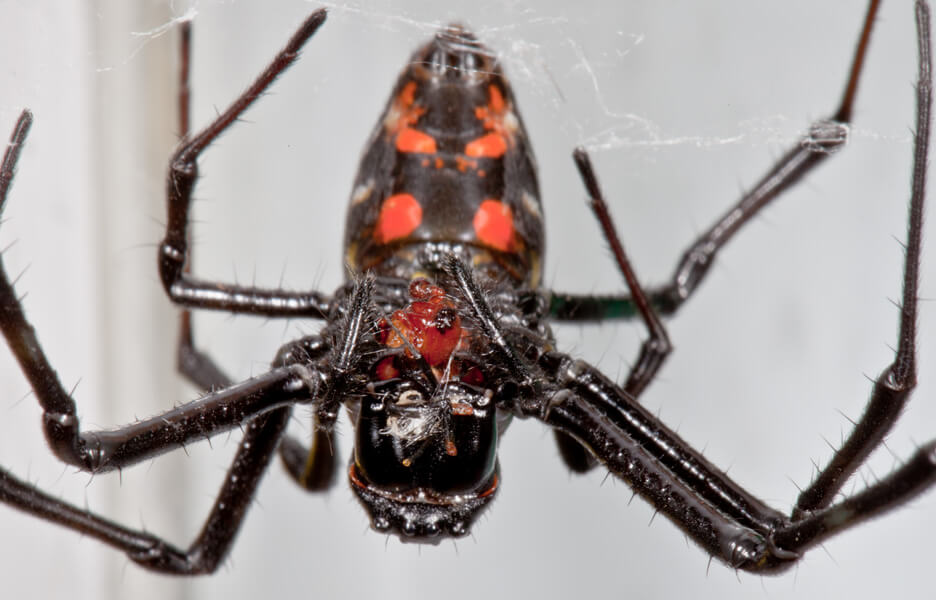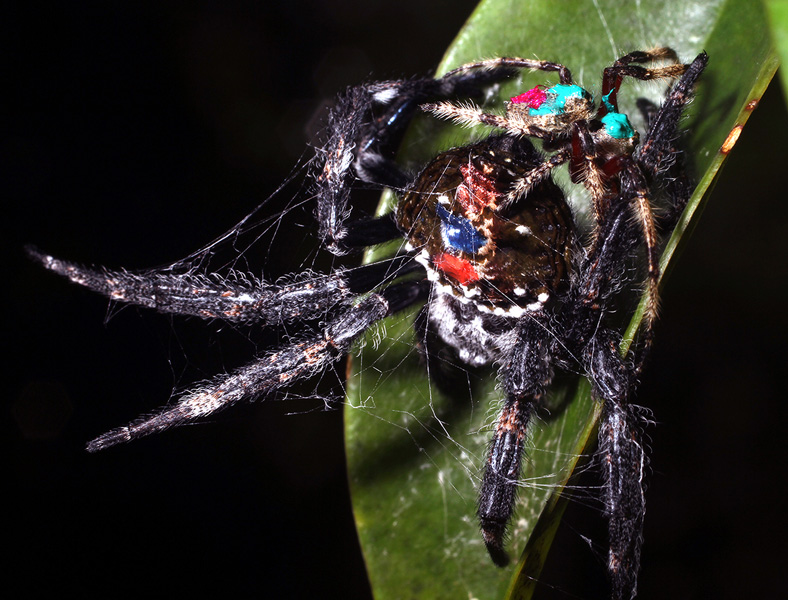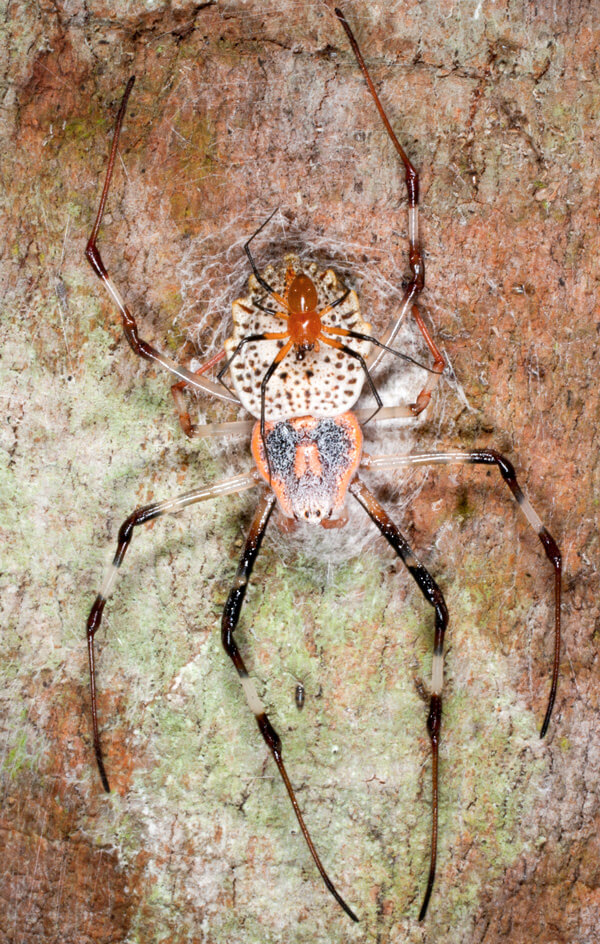First, the confession: I’m an arachnophobe, spooked by the most harmless everyday spiders. Close encounters with the scarier sort — the goliath bird-eating spider in an undergraduate zoology class, the venomous redbacks sharing my tent on a research trip to Australia — well, let’s just say they taught me more about myself than about arachnids. And yet I’ve discovered a soft spot for one group of spiders: those undersized males faced with the daunting prospect of sex with a giant mate, often one with murder in mind. Think Attack of the 50 Foot Woman, only with spiders.
Why the sympathy? It’s not because these puny males risk their lives for love. It’s because they’ve evolved such a bizarre array of ways to achieve their ultimate goal of siring spiderlings with a monster of a mother.
Sexual size dimorphism — where one sex is bigger than the other — is nothing too much out of the ordinary: Picture a massive male orangutan, or the bull elephant seal towering over his harem. And many insects and other terrestrial arthropods have large females, because a bigger body can produce more eggs.
Spiders, though, beat all comers: Females can be 3 to 10 times the size of males, and occasionally more. Most of these mismatched pairs are web-spinning spiders, notably orb weavers and widows. Female giant golden orb weavers (Nephila pilipes) are 10 times as long as males, for example, and a formidable 125 times heavier.
Welcome to the world of eSSD — extreme sexual size dimorphism.
Such spectacular discrepancies have consequences, and the most notorious is cannibalism. Giant female spiders that sit in their webs waiting to be wooed are the very definition of femmes fatales, prone to snacking on their suitors before, during or after copulation. Why? Because they are big and so they can, getting not only a half-decent dinner out of it, but also controlling who gets lucky and who doesn’t.

The one that didn’t get away: Giant female spiders are notorious cannibals that often make a meal of prospective mates. Male Asian hermit spiders (Nephilengys malabarensis) have several strategies to improve their chances of avoiding death and siring spiderlings. Some, like this miniature male, still fall foul of the female’s fangs.
CREDIT: MATJAŽ KUNTNER
Less familiar is the amazing repertoire of male behavior in these species, all aimed at enhancing paternity. While females merely wait, males must roam in search of mates. When they find one, they may have to fight off rivals, must avoid being eaten long enough to copulate, and must try to stop other males from impregnating the female after they’re done. And that has led to some astonishing tactics.
“Sex in animals can be weird, but this is really weird. It’s like a soap opera,” arachnologist Jonathan Coddington tells me. As curator of arachnids at the Smithsonian National Museum of Natural History in Washington, DC, he’s spent decades investigating the evolution of spiders and observing their odd sexual habits.
Spider sex is unique even leaving aside extreme size differences. Mature males squirt their sperm onto a tiny “sperm web,” then siphon up the sperm into appendages on the sides of the head for storage until mating. In females, these appendages — called pedipalps — are leg-like structures used to prod and probe prey, but in males the tips are transformed into sperm-delivery organs.
During copulation, the male inserts one palp into an opening in the female’s abdomen, and pumps in sperm. If he gets the chance, he’ll insert his second palp into the female’s other opening. There, his sperm — and that of any subsequent successful male — is stored in pouches called spermathecae until the female begins laying eggs. At that point, the sperm are activated, travel into the egg-laying canal and fertilize the eggs.
For odd-sized mates, this process poses some tough challenges, but before you jump to conclusions, badly fitting sex organs isn’t one of them. “Evolution has taken care of things so the genitals of gigantic females are relatively small and those of small males are relatively large,” explains Slovenian spider specialist Matjaž Kuntner of the National Institute of Biology in Ljubljana. A bigger problem is surviving long enough to finish copulation and fertilize all or most of the female’s eggs.
Spider reproductive organs are amazingly varied, but those of species that exhibit extreme sexual size dimorphism all have the same basic arrangement. In the female, a hard genital plate (epigynum) shields a pair of copulatory openings and a central egg-laying duct. The male’s pedipalps are modifed to store sperm before mating and then squirt them into the female’s copulatory openings. After mating, sperm are held in a pair of pouches (spermathecae), until the female begins to release eggs from her ovaries. As eggs travel towards the genital opening, sperm are released from storage to fertilize them.
Taking precautions
Male orb weavers approach with caution from behind, keeping as far from female jaws as possible. In many species, males pick a time of least peril if they get the chance: when the female is already eating or when she is molting for the last time before adulthood. Molting females can’t attack until their soft new exoskeletons harden.
German zoologist Gabriele Uhl at the University of Greifswald checked how well this strategy serves the black-and-yellow-striped wasp spider (Argiope bruennichi). In lab studies, 97 percent of males that mated with the soft, molting females survived, compared with 20 percent that tried to mate with a hardened one. What’s more, mating a still-soft female allowed males to copulate for longer and gave them the option of emptying both palps or trying their luck with a second mate.
In her study, Uhl estimated that about 45 percent of the wasp spider males mated with molting females. It’s hard to know how common a tactic this is among other spiders, because molting happens fast, and often at night. “Researchers would have to stay up all night to observe it,” Uhl says. But she assumes it’s widespread, because males of many species are known to hang out in and around the webs of immature females. And it’s a tactic that pays, she says. “It’s highly likely that males mating molting females sire all of their offspring.”
Some male spiders resort to soothing gestures when danger looms. If the female giant golden orb weaver breaks off mating (a bad sign), the male binds her with silken threads. The bonds aren’t strong enough to immobilize her, but the caressing action relaxes her enough to resume mating. That might also explain why Darwin’s bark spider (Caerostris darwini) performs oral sex, salivating on the female’s genitals before copulation. This recently discovered behavior has been observed only in this particular spider species, but researchers suspect it could be widespread.

Darwin’s bark spider (Caerostris darwini) has many claims to fame: the largest webs, the strongest silk and several strategies for surviving sex. This is the only spider known to indulge in oral sex. Male spiders also go in for mate binding, a gentle form of bondage with silk that helps to reduce female aggression.
CREDIT: MATJAŽ GREGORIČ
And then there’s the sensible if impossible-sounding strategy of remote copulation. That’s not quite what it seems, as demonstrated by the Asian hermit spider (Nephilengys malabarensis). When danger threatens, the male snaps off his pedipalps and makes good his escape, leaving the palps to pump sperm without him.
So far, so bizarre. But that’s not the end of it. The evolutionary interests of male and female aren’t always the same, making sex a battleground in more ways than one. His interests lie in passing on his genes, so he benefits from fathering all of his mate’s offspring. For the female, monogamy is not such a good idea: She wants offspring with the best possible genes, so she can either be picky or mate with multiple males, increasing the odds that some of her spiderlings will turn out well.
This conflict has led to the evolution of measures and countermeasures by each sex to get what they want. Females eat males they don’t want to mate with, or to avoid being monopolized by a single partner. Males have acquired ways to thwart females. “For males, the chances of finding a second female to mate with are practically nil, so he invests everything in success with one mate — and that’s led to a lot of bizarre behaviors,” Coddington says.
For example, males often congregate in a female’s web, where they fight to be first in line to try their luck. Successful males try to secure paternity by preventing rivals from adding their sperm to her store. They may try to plug the female’s copulatory openings by leaving behind the ends of their palps, or even entire palps. Even then, and assuming they survived mating, they often guard the female jealously, fighting to fend off other suitors. Asian hermit spiders that complete copulation without having to flee part way through and finish the job remotely still leave their palps behind when they’re done. A study from Kuntner’s lab showed that 87 percent of them abandon their palps this way, chewing them off if necessary. The team also showed that these “eunuch” males are more agile, superior fighters, better able to guard their mate.
Not all genital plugs work, though, as Coddington is at pains to point out. The giant golden orb weaver’s pedipalps end in long, hair-like extensions. “He sticks it in the female; it breaks off and it doesn’t do any good at all,” Coddington says. “We find females with eight or more stuck inside them.”

Many male spiders try to monopolize females by plugging their copulatory openings with cast-off parts of pedipalps, with varying success. Left: The copulatory opening of a female Nephila constricta has fine filaments from the tips of three males’ pedipalps protruding from a single copulatory opening. Right: The genitals of the coin spider Herennia multipuncta are effectively plugged by a single male, which has castrated himself to leave the entire “penis” part of his palps behind.
CREDIT: MATJAŽ KUNTNER
Head over heels
Some spider males sacrifice more than their genitals. They positively encourage the female to eat them — because that buys them time to complete copulation. The male redback spider (Latrodectus hasselti) performs a suicidal somersault once he’s finished his first copulation, twisting his body around until the abdomen rests on the female’s fangs. As she begins to eat him rear-end first, he carries on copulating, inserting his second palp to deliver the remainder of his sperm.
It doesn’t always end that way, however. In 2016, Canadian and Israeli researchers reported the discovery of an alternative, safer, strategy: Male redbacks and brown widow spiders (Latrodectus geometricus) will bite their way through the unmolted, virgin female’s exoskeleton to gain access to the copulatory openings concealed within. The team found that males doing this not only survive but usually copulate twice, block both openings with broken-off palps, and achieve a higher rate of paternity than they do with adult females. Males that get the chance to mate this way, will do it: The Canadian study found that fully one-third of immature female redbacks collected from the field had already been mated.
Spectacular though all this is, extreme sexual size dimorphism is rare even in spiders. “It’s an aberration,” Kuntner says. Even so, as he and Coddington describe in the Annual Review of Entomology, close examination of the evolutionary history of spiders indicates that eSSD has evolved at least 16 times, and in one major group some lineages have repeatedly lost it and regained it. The phenomenon is so intriguing it’s kept evolutionary biologists busy for decades. How and why did something so weird evolve?
There have been many suggestions. Males shrank to become dwarfs. Females ballooned into giants. Maybe a bit of both? As for the forces driving the sexes apart, there are lots of contenders.

A small male coin spider, Herennia multipuncta, stands guard over his mate, ready to fend off further suitors. Males that castrate themselves during sex are better fighters than their intact rivals.
CREDIT: MATJAŽ KUNTNER
To get at some answers, Kuntner and Coddington zoomed in on two groups of spiders for which there are accurate and detailed genealogies and good data on size — the golden orb weavers and the argiopines (wasp spiders and their kin). “These show trends in size as the lineages have evolved,” Kuntner says. Both sexes got bigger over time, but while males appear to have increased toward an optimum size, females kept going, with some becoming giants.
The question of what drives the evolution of odd-sized couples is harder to answer, and biologists have proposed many possible explanations over the decades. “You’d think there would be a single simple explanation for why it happens,” Coddington says. He and Kuntner weighed all the evidence for and against each of the contenders and concluded that, actually, there isn’t. Instead, they suggest it’s a consequence of several, possibly opposing, selective forces acting on each sex independently. Natural selection, sexual selection, conflict between males and females, and ecological factors: All probably contribute.
Under pressure
Spiders face a combination of pressures that could drive size one way or the other, some more strongly than others. The bigger a female, the greater her fecundity, so natural selection would drive size upward. But if predators pick off larger spiders, that would push for smaller size. So, too, might the need to defy gravity to build a web.
Males face different pressures: They have to walk, climb and traverse silk bridges as they seek out a mate, then avoid being eaten, which might encourage small size; but they might also have to fight rivals — where bigger is better. “What we do know is that once spiders exhibited eSSD, they evolved all those bizarre behaviors to deal with it,” Kuntner says.
Even more of a mystery is the genetic mechanism that has enabled male and female to evolve along separate paths. But the fact that they do has led not just to size discrepancies and wacky sexual habits, but also to startling differences in shape and color — some so dramatic that males and females have often been described as separate species.
End of the line
Sadly, for those like me who appreciate nature’s weirder side, there’s another twist to the story. Spiders with the most extreme size differences could be heading for extinction. “We think they might be evolutionary dead ends,” Kuntner tells me.
Being a giantess has advantages, but it also carries risks. Smaller spiders infest the huge webs of outsize females and steal food. Recently, the invaders have been found to eat not just the web owners’ prey but also sometimes their eggs. That’s a high price to pay for being big.
The idea of evolutionary dead ends is controversial, but in earlier work Coddington showed that other changes to spider lifestyle haven’t gone so well. Specifically, spiders that swapped their solitary habits for a social lifestyle have failed to diversify into new species: They are effectively the end of their line. Close inspection of the orb weaver family tree shows that eSSD species also tend to sit at tips of branches and are likely going nowhere. “In ecological time, they are sucked into a strategy that looks like a good idea but predisposes them to extinction,” Coddington says. “It’s good in the short term but in the long term it’s fatal.”
Arachnophobe that I am, there’s part of me that’s relieved to think that the chances of meeting giant cannibal spiders could be receding, albeit on an evolutionary timescale. But my heart bleeds for those mini-males. All that fang-dodging, palp-chewing and self-sacrifice, so much effort and sexual innovation, and where does it lead? Perhaps only to oblivion.




